This page has been formatted to facilitate printout of the review.
Use your browser's "Back" button to return to the previous page, or the links at the top and bottom of this page to navigate to related information. If you have difficulty fitting the text on this page onto your printer output, simply resize your browser window to a narrower width and print again.
Remember us when it's time to buy!
Dave here: Have our reviews been helpful to you? (Is this article you're reading right now useful?) Preparing this level of information on as many products as we do is incredibly hard work, not to mention expensive. Things on the Internet may look like they're free, but they're not. (As a lot of big dot.com companies are finding out these days.) Somewhere, somebody has to pay to produce worthwhile content. YOU can help us though, by remembering us when it comes time to make your purchase. Would you consider coming back to our site and clicking-through to one of our advertisers to make your purchase? Every dollar you spend with one of our advertisers helps us directly (in affiliate fees) or indirectly (the advertiser will keep renewing their ad contract with us). To make it easy for you to support us, here's a URL you can visit, to see all our current advertisers, with links to click on that will register your visit to them as having come from our site. It's up to you where you buy, but Mike, Mike, Kim, Yazmin, Marti and I would be really grateful if you'd help us out by choosing one of our advertisers to purchase from.
Thank you for your support!
Dave Etchells, Founder & Publisher
Visit our "Buy Now" Page:
https://www.imaging-resource.com/buynow.htm
 Back
to Full Sony MVC-FD95 Review
Back
to Full Sony MVC-FD95 Review
Go to Sony MVC-FD95
Data Sheet
Go to Sony MVC-FD95
Pictures Page
Up to Imaging Resource Cameras
Page
Sony MVC-FD95
Sony takes the Mavica line to 2.1 megapixels, and 12-bit digitization!
Review First Posted: 7/13/2000
|
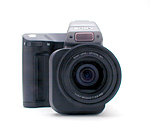
MSRP $999 US
|
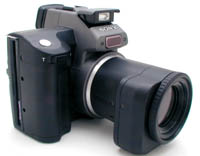 |
* |
2.1 megapixel CCD, up to 1600x1200
images
|
|
* |
10x optical , 2x digital
zoom
|
|
* |
Records movies with
sound
|
|
* |
JPEG, GIF, TIFF, and MPEG file
formats
|
| * |
Floppy or Mem Stick w/adapter for
easy computer interface |
|
Manufacturer Overview
More than
any other single company, Sony has dominated the digital camera market the last
few years, thanks in large part to the easy computer interfacing offered by
their Mavica(tm) line of floppy-disk based cameras. They've also been active at
the high end of the market, with products like the DSC-D770 and DSC-F505, which
caught the eye of many pros and advanced amateurs for their excellent optics and
exposure control.
This spring (February, 2000),
Sony stunned the digicam world by announcing no fewer than six new
models. Part of this was a significant extension of their Mavica line, bringing
the higher end up to the 2 megapixel resolution range, while incorporating a
number of enhancements in the basic camera electronics and signal processing as
well. To accommodate the larger image sizes that come with the new 2.1 megapixel
resolution, they cleverly used a special version of the "FlashPath" floppy disk
memory card adapter in conjunction with their Memory Stick technology to deliver
"floppy disk" cameras with potential storage capacities as high as 64 megabytes.
On the signal-processing front, they incorporated 12-bit digitization, which
results in exceptional tonal range, excellent preservation of detail in strong
highlights, and excellent low-light capability. This review covers the new high
end of the floppy-based Mavicas, the MVC-FD95.
Highlights
- 1/3 inch CCD delivering up to 1600 x 1200 resolution images.

- 2.5 inch, color, TFT LCD monitor.

- Smaller, LCD optical viewfinder with data display.

- 10x, 6 to 60mm lens (equivalent to a 39 to 390mm(!) lens on a 35mm camera.
- 2x digital telephoto.

- Steady Shot option to decrease camera shake.

- Program AE, Aperture Priority, Shutter Priority, Twilight, Twilight Plus,
Landscape and Panfocus capture modes.

- Shutter speeds from 8 to 1/500 seconds.

- Automatic, Outdoor, Indoor and "One-Push" manual white balance
settings.

- Built-in, popup flash with Automatic, Red-Eye Reduction, Forced and
Suppressed modes and manually adjustable intensity settings.

- Spot metering option.

- 10 second self-timer.

- MPEG movie record mode.

- Voice Memo record mode.

- E-Mail and Text (GIF) still image record modes.

- Manual focus option.

- Image storage on 3.5 inch floppy disks or Sony MemorySticks with
adapters.

- InfoLITHIUM battery system.
Executive
Overview
As with other models in Sony's Mavica digicam, you
may be thinking that the MVC-FD95 is a bit of a handful. We initially thought so
too, since the FD95's large size stands out from the more pocket-sized digicams
we commonly test. Don't let its size fool you though, what the FD95 lacks in
compact portability, it well makes up for in many other areas. For example, the
larger camera size is necessary because it actually stores images on 3.5 inch
floppy diskettes (a feature which has earned Sony much popularity in the
consumer marketplace). With image storage on floppies, you're free from the
hassles of cables, download software and compatibility issues. Despite its
appearance, the camera actually weighs quite a bit less than you'd think by
looking at it (34 oz. or 970g), thanks to its sturdy, all plastic body. Combine
that with the 10x optical zoom, loads of features and the MPEG movie capability,
and you'll appreciate just how much Sony has actually packed into the FD95's
body.
The MVC-FD95's optical viewfinder is an intriguing feature, as it
appears to be a smaller version of the rear LCD monitor, complete with
information display and menus. The "optical" viewfinder actually uses a tiny
(and lower-power) LCD screen to show you what the camera's seeing (a little like
an "electronic SLR" or single-lens reflex). We like the idea of being able to
see the exposure settings, flash, etc. in the viewfinder, but we also found it a
little difficult to navigate the menu system with your face so close to the
camera and preferred to switch over to the larger LCD monitor when making menu
selections. The MVC-FD95 offers a 10x optical zoom with its 6 to 60mm lens
(equivalent to a 39 to 390mm lens on a 35mm camera). The lens also features
Sony's remarkably effective "Steady Shot" system that helps you hold the image
steady when you're shooting at the extreme telephoto settings the FD95 is
capable of. Focus ranges from 9.8 inches (25 cm) to infinity in normal mode and
from an amazing 0.8 to 9.8 inches (2.0 to 25 cm) in Macro mode. Finally,
apertures range from a very fast f/2.8 to f/11. There's even a manual focus
mode, where you can focus the lens by hand, using the ridged focus ring on the
end of the lens, just like traditional manual focus lenses for film
cameras.
Although there's no full manual exposure option, Sony does give
you both Aperture Priority and Shutter Priority exposure modes. In these, you
select one value while the camera chooses the most appropriate corresponding
one. There are also Twilight and Twilight Plus modes that extend low-light
performance (although not to true night-photography levels - use the shutter
priority exposure option for that), and a full Program AE for times when you
want the camera to do all the work. Landscape mode locks the focus at infinity
and Panfocus allows you to quickly change focus from far away to close-up
subjects. Both modes are perfect for fast action shooting situations when you
don't have time to wait the second or so that the autofocus system requires. We
were glad to see the inclusion of a manual (One-Push, as Sony calls it) white
balance mode in addition to the standard Automatic, Indoors and Outdoors
options. We also appreciated the spot metering option, which gives you greater
flexibility over your exposure with backlit and other difficult subjects. The
on-board pop-up flash gives you some added control as well, letting you set its
intensity level. Combined with one of the semi-manual modes and the capability
of connecting an external flash, you have a good bit of control over flash
exposure. There's also a sharpness control and an entire menu of picture
effects, which let you shoot images in black and white or sepia monotones, with
a solarized effect, or as negative art.
Aside from the traditional still
capture mode, the MVC-FD95 has a movie option that lets you record up to 60
seconds of images and sound in a 160 x 112 pixel size and up to 15 seconds at a
320 x 240 size. Movies are recorded as MPEG files and most of the same exposure
options are available as for still images. Additionally, you can record up to 40
second sound clips to accompany still images. Under the capture mode menu, the
MVC-FD95 gives you the added option of recording still images as black and white
GIFs (good for capturing text or white boards) or email-friendly images (320 x
240 size for easier email transmission) at the same time as higher-resolution
ones.
As we said earlier, the MVC-FD95 stores images to a 3.5 inch floppy
diskette. This makes it exceptionally easy for users to transfer images to a
computer. Simply pop out the disk and insert it into your computer's floppy
drive. There's no cabling to figure out and you don't have to worry about using
the AC adapter while downloading to save battery power. The downside to floppy
storage is that the 1.44 megabyte floppy capacity limits you to only 4 high
resolution images on each disk. You can also purchase an adapter and save images
to Sony's MemorySticks, storing up to 64 megabytes of images on a single card.
Of course, the adapter/memory stick approach loses the floppy's benefits of low
cost and no need for special driver software.
Packaged with the camera is
ArcSoft's Camera Studio software bundle, compatible with Windows and Mac
operating systems. This package makes it simple to collect images, display them
in a slide show or photo album as well as make minor corrections (take out
Red-Eye or enhance color, etc.) and make creative image manipulations. Also
included is a basic video editing program, for enhancing your MPEG
movies.
For power the MVC-FD95 runs on Sony InfoLITHIUM NP-F330
rechargeable battery packs (NP-F530 and NP-F550 packs can also be used). What's
great about the InfoLITHIUM system is that the batteries communicate with the
camera about its power consumption. The resulting information appears to you as
remaining battery time in minutes displayed on the LCD next to a battery symbol.
The camera has an auto power-off option which shuts down the camera after three
minutes of inactivity. This is great from a battery conservation standpoint, but
we'd like to be able to adjust the timer somehow.
After all our testing,
we really liked the versatility of the MVC-FD95. The combination of a 10x
optical zoom, whimsical picture effects, the MPEG movie capability and the use
of floppy disks make this a fun camera to use. The optical stabilization on the
10x zoom lens makes it far more useful at telephoto settings than it would be
otherwise. We think that novice consumers and advanced amateurs alike will find
much to like about the FD95: You get enough exposure control to get creative,
with the luxury of a full automatic mode when you want to take it
easy.
Design
As the most recent addition to Sony's
Mavica series, the FD95 reflects the line's tendency toward larger body styles,
dictated by the physical dimensions of the included floppy drive. Despite
first-guess estimates based on its hefty size, the camera feels lighter than
you'd think. Weighing in at 34 ounces (970 g), including the battery pack, the
FD95 is just one ounce heavier than the previous top-of-the-line FD91 model.
Although that's a great deal more weight than many smaller digicams carry, it's
still lighter than what your first assumption might be, mostly due to the tough
plastic body. The camera's overall size is 5 x 5 x 7.25 inches (126 x 124 x 184
mm). While the FD95 won't easily slip into your coat pocket, (the size must
accommodate the required floppy disks and the very long-ratio zoom lens), the
accompanying neck strap makes it easy to tote.
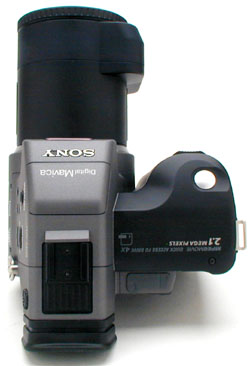
The top of the FD95 is fairly plain, holding the shutter button,
pop-up flash, external flash mount and external flash sync connection. You can
also see the ridged manual focusing ring on the front of the lens in this
view.
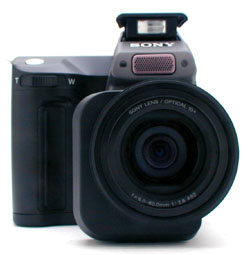
The rather large lens dominates the front of the camera, with a
squared off rest to keep the lens from banging when the camera is set down.
(This "rest" also houses the Steady-Shot system.) Also on the front of the
camera is the zoom control lever and microphone.
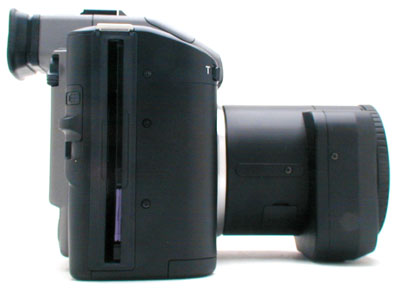
We liked the bulky hand grip on the side of the camera, which gives
you a nice, solid hold. Conveniently, the floppy disk slot is also on this side,
making it simple to change disks in and out when the camera is mounted on a
tripod.
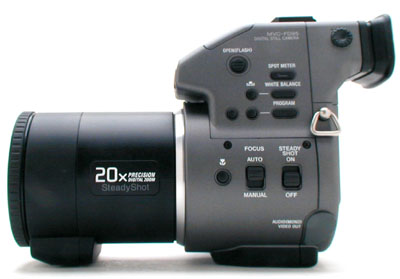
The majority of the camera's controls are on the left side of the
camera (when viewed from the back), which we're more accustomed to after working
with other Mavica models. Zoom, focus, Steady Shot, white balance, Program AE,
spot metering and macro options are all controlled from this side. An
audio/video out terminal also resides on this side of the camera (at the
bottom), which is protected by a flexible rubber flap that conveniently slides
out of the way when opened. There's also a dioptric adjustment dial on the side
of the optical viewfinder, to accommodate near and farsighted users.
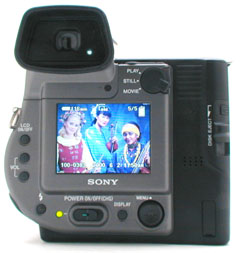
Some controls do remain on the back panel though, namely power,
capture mode, flash, volume, the menu button, LCD on/off button and the display
button. The optical viewfinder and LCD panel also live back here (this time the
LCD display is stationary, unlike some Mavica models where the LCD panel
actually flips upward or has swiveling capability). We liked the idea of having
an information display in the optical viewfinder, but ultimately still found it
a little awkward navigating through menus with our face pressed against the back
of the camera.
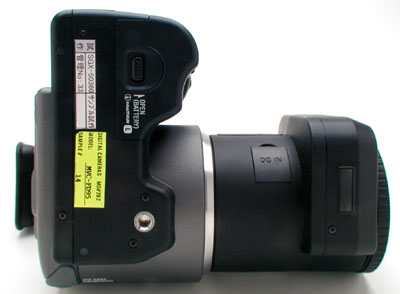
We greatly appreciated the placement of the tripod mount and the
battery compartment. They're just barely far enough away from each other to
allow battery changes while mounted. The metal threads of the tripod mount also
gave us a bit more security that we wouldn't strip them when we tightened down
the tripod screw. Our only complaint with the tripod mount was that the socket
doesn't have a lot of flat area around it, particularly toward the front of the
camera. This made it more prone to front-to-back rocking when mounted on the
tripod.
Viewfinder
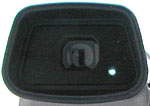 The MVC-FD95 offers both a rear LCD panel and optical
viewfinder (which seems to be a smaller version of the LCD). The "optical" viewfinder
actually uses a tiny (and lower-power) LCD screen to show you what the camera's
seeing. Sort of an "electronic SLR" (single-lens reflex), similar to the design
of the MVC-FD91 model. What makes the optical viewfinder interesting is the
internal information display, which is identical to that of the LCD monitor
(complete with navigable menus). The idea of being able to see the exposure
settings in the viewfinder is a good one, but navigating the menus through the
optical viewfinder is a bit of a trick (one we weren't able to easily do). We
found it much easier to simply switch on the LCD monitor when we needed to change
menu options. The optical viewfinder does feature a dioptric adjustment dial
for eyeglass wearers, which is always a nice bonus. The 2.5 inch LCD monitor
is turned on and off by the LCD On/Off button directly to its left, and the
information display is controlled by the Display button just beneath the monitor.
The MVC-FD95 offers both a rear LCD panel and optical
viewfinder (which seems to be a smaller version of the LCD). The "optical" viewfinder
actually uses a tiny (and lower-power) LCD screen to show you what the camera's
seeing. Sort of an "electronic SLR" (single-lens reflex), similar to the design
of the MVC-FD91 model. What makes the optical viewfinder interesting is the
internal information display, which is identical to that of the LCD monitor
(complete with navigable menus). The idea of being able to see the exposure
settings in the viewfinder is a good one, but navigating the menus through the
optical viewfinder is a bit of a trick (one we weren't able to easily do). We
found it much easier to simply switch on the LCD monitor when we needed to change
menu options. The optical viewfinder does feature a dioptric adjustment dial
for eyeglass wearers, which is always a nice bonus. The 2.5 inch LCD monitor
is turned on and off by the LCD On/Off button directly to its left, and the
information display is controlled by the Display button just beneath the monitor.
The advantage of an eye-level viewfinder, as provided by the "optical" viewfinder
is that it both promotes a more secure camera grip (arms clamped to your sides,
camera body braced against your face) that helps with long telephoto and low-light
shots. It also provides a more natural "look & shoot" operation than when
you're forced to rely on a rear-panel LCD display. The downside of having the
"optical" viewfinder be electronically drive though, is that you're left with
no usable viewfinder option when the light levels get really low: The FD95 has
excellent low-light capability, and in fact can shoot in conditions about as
dark as you're likely to be able to see in. The electronic viewfinder system
needs much more light to operate though, meaning that you'll have to either
look at the finished shot and readjust the framing as needed, or just shoot
at a wider-angle setting than otherwise, and hope to get all of the subject
in the frame. We'd really like to see at least some option for
optical alignment of the camera, even if only a "gunsight" sort of device that
could attach to the accessory shoe. (Are any of you third-party manufacturers
out there listening? - This could be a nifty add-on gadget for FD-95 owners!)
As you'd expect, the "optical" and LCD viewfinders on the FD95 are in exact
agreement with each other, no surprise given that they both display the same
image. We found about 92 percent accuracy in both the wide angle and telephoto
modes.
Optics
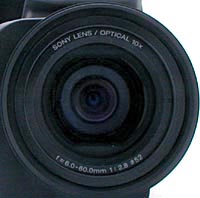 The MVC-FD95 is equipped with a 10x, 6 to 60 mm lens (equivalent to
a 39 to 390mm lens on a 35mm camera). The FD95 also boasts the surprisingly
effective "Steady Shot" anti-vibration system, which increases your chances
of being able to hand-hold exposures with such a long telephoto. (The rule of
thumb in the film-camera world has always been that you should use a shutter
speed of one divided by the focal length of your lens in millimeters, to avoid
blur from camera shake. Thus, for a 400 mm lens, you should use a shutter speed
of at least 1/400 of a second.) As we discovered with the FD91, the Steady Shot
system does an excellent job of steadying the image in the viewfinder when working
at the maximum telephoto setting. While we don't have any objective way to measure
how effective the Steady Shot system is, our distinct impression was that the
FD95's Steady Shot system is significantly improved over that of the earlier
FD91: It really does provide an amazing reduction in the amount of camera shake
that makes it through to the CCD!
The MVC-FD95 is equipped with a 10x, 6 to 60 mm lens (equivalent to
a 39 to 390mm lens on a 35mm camera). The FD95 also boasts the surprisingly
effective "Steady Shot" anti-vibration system, which increases your chances
of being able to hand-hold exposures with such a long telephoto. (The rule of
thumb in the film-camera world has always been that you should use a shutter
speed of one divided by the focal length of your lens in millimeters, to avoid
blur from camera shake. Thus, for a 400 mm lens, you should use a shutter speed
of at least 1/400 of a second.) As we discovered with the FD91, the Steady Shot
system does an excellent job of steadying the image in the viewfinder when working
at the maximum telephoto setting. While we don't have any objective way to measure
how effective the Steady Shot system is, our distinct impression was that the
FD95's Steady Shot system is significantly improved over that of the earlier
FD91: It really does provide an amazing reduction in the amount of camera shake
that makes it through to the CCD!
With a maximum aperture of f/2.8, the FD95's lens is quite "fast," great for
sports and other action shots (the larger aperture letting in more light, and
permitting a shorter shutter speed), as well as providing an option for isolating
your subjects with shallower depth of field. The lens has 52mm filter threads,
which allows you to attach specialty filters and auxiliary lenses. The 2x digital
telephoto can be turned on and off through the record menu, and effectively
extends the camera's zoom range to 20x. However, quality is always an issue
with digital telephoto, as the camera is simply enlarging the center portion
of the image and thereby decreasing the image quality (which shows up as higher
noise levels or softer resolution). Focus ranges from 9.8 inches (25 cm) to
infinity in normal mode and from 0.8 to 9.8 inches (2.0 to 25 cm) in macro mode.
Macro mode is controlled by the Macro button on the left side of the camera
(when looking at the back). The MVC-FD95 does an excellent job in the macro
category, capturing a minimum area of 1.42 x 1.06 inches (35.96 x 26.97mm) at
its closest setting (there appears to be a "sweet spot," where the lens lets
you zoom in just a little in Macro mode).
Focus can be manually or automatically controlled, simply by sliding the Focus
switch on the same side of the camera (next to the Macro button). Once in manual
focus, you control focus by turning the ridged focus ring at the end of the
lens. When you do so, the LCD viewfinder immediately switches to a 2x enlarged
view, which helps you determine whether you've achieved proper focus or not.
When in autofocus mode, the camera continuously sets the focus. The camera lets
you know when images are in focus and when the exposure is locked through indicators
on the display. When the green circle is solid, the camera is ready to snap
the picture.
In the time between our first testing of the FD95 and writing this review, we've
heard from a number of early purchasers of the camera. A complaint many have
voiced is the cameras tendency to "freeze" the viewfinder display whenever the
shutter button is pressed, or when the manual focus bezel is moved. This is
in fact a significant issue when shooting action subjects, as a lot can happen
while the display is either frozen or transitioning between modes. Without special
handling, this makes the camera of decidedly less value in shooting sports action
and other fast-changing subjects. We did find a bit of a workaround to this
problem though: It turns out if you just hold the shutter button half-pressed
in manual focus mode, the display will revert to normal size, yet you can continue
to operate the focus ring manually to follow the action. The on-screen distance
display continues to show the distance in real-time, which can help you get
the right focus in spite of the smaller screen display. This is still a trifle
inconvenient (you have to keep your finger gently pressing the shutter button),
but it does seem workable. In a note to the Sony engineers, it'd be nice to
have a setup menu option to disable the jump to 2x size when you twiddle the
manual focus adjustment. Likewise, why must the display freeze when you
push the shutter button? - It sure would be nice if it could stay "live"...
The camera's Aperture Priority mode allows you to manually select the lens aperture
from f/2.8 to f/11 in 1/2-stop increments, while the camera selects the appropriate
corresponding shutter speed. Two quick focus modes, Landscape and Panfocus,
allow you to preset specific focal distances for fast shooting situations. Landscape
sets focus at infinity for far away subjects and Panfocus allows you to change
focus quickly from close-up to far away subjects. We can see how these modes
would be helpful at kids' soccer games and other sporting events, when the fast
paced action doesn't give you much time to fool with focus.
In our testing, we found optical distortion a little high at the wide angle
end of the lens range, as we measured about 0.9 percent barrel distortion. However,
we found virtually no pincushion distortion at the telephoto end (at least none
that we could effectively measure). Chromatic aberration was moderate, showing
about two pixels of coloration on each side of the black resolution target corner
elements. (This distortion is visible as a very slight colored fringe around
the objects at the edges of the field of view on the resolution target). There
is also some lens flare in the corners of the image in telephoto mode. Overall,
a very good performance for a lens with such a wide zoom ratio.
Exposure
With
its variety of Program AE modes, the MVC-FD95 gives you a fair amount of
exposure control, although it doesn't offer the full manual control that we'd
like to see on a high end camera of this sort. In addition to the standard
Automatic exposure mode which controls both aperture and shutter speed, the
MVC-FD95 offers Aperture Priority, Shutter Priority, Twilight, Twilight Plus,
Landscape and Panfocus exposure modes. Both Aperture and Shutter Priority modes
give you control over the corresponding setting while the camera controls the
other. As we mentioned earlier, aperture can be manually set from f/2.8 to f/11
and shutter speed spans from eight to 1/500 seconds. Manually selected aperture
values are in 1/2 f-stop increments, while the shutter speed step size varies as
a function of the speed range you're working in. At very long shutter times, the
steps are in full-stop (2x) increments, while at very high speeds, they're in
half-stop increments. In the critical mid-range, speeds of 1/60, 1/90, 1/100,
1/125, and 1/180 are offered, giving approximately third-stop increments. The
Twilight modes simply adjust the aperture and shutter speed for dark settings
like night skylines and fireworks. Normal Twilight mode sets the exposure system
to somewhat underexpose the image, so bright lights, the sunset, neon signs, etc
won't wash out, but retain their full color. Twilight Plus makes less exposure
adjustment, but boosts light sensitivity for taking pictures under darker
conditions. As mentioned above, Landscape and Panfocus modes apparently only
affect the lens focus, although Panfocus apparently also chooses a smaller lens
aperture for greater depth of field.
When shooting in Program AE, you do
have control over the exposure compensation through the display menu. You can
adjust the exposure from -2.0 to +2.0 EV in 1/3 EV increments. (Each full EV
unit corresponds to a doubling of halving of the exposure.) White balance is
also easily controlled, by a button on the side of the camera, with options for
Automatic, One-Push, Outdoor and Indoor. One-Push lets you manually adjust the
white balance by placing a white card in front of the lens and pressing the
manual adjustment button until the white value is set. We liked the inclusion of
the spot metering mode, which takes the exposure values from the very center of
the composition as opposed to averaging values from the entire image. Spot
metering is useful for high contrast subjects, where you'd rather have the
exposure set for a specific highlight or dark area. A self-timer (accessible
through the on-screen menu) gives you a 10 second countdown on the LCD monitor,
complete with an audible beep, after the shutter button is fully pressed.
There's also a sharpness setting through the capture menu, which allows you to
adjust the image sharpness from -2 to +2 levels, although we found differences
between sharpness settings to be very subtle.
The FD-95's low-light
performance is one of the areas of most dramatic improvement relative to
previous Mavica models. In our testing, the camera's Automatic and Twilight
exposure modes didn't do extremely well in low light situations (we got barely
useable images at 0.5 foot candles, or roughly 5.5 lux), but this was still a
drastic improvement over earlier models. We saw the best results when using the
Shutter Priority mode, which gave us useable images as low as 1/16 foot candles,
or only 0.13 lux (although the image was relatively dark, there's still a good
amount of detail). This is really extraordinarily dark, and the FD-95 does as
well or better in this category than the vast majority of digicams currently on
the market. (June, 2000)
We suspect the exceptional low light performance
of the FD95 has much to do with its 12-bit digitization (most digicams use only
8 or 10-bit digitization). The 12-bit A/D (analog/digital) conversion of the
FD95 also shows up at the other extreme of the tonal range as well: We found
that the FD95 did an unusually good job of preserving detail in strong
highlights, as seen in our outdoor portrait test shot, taken under direct sun,
and in the strong highlight on the front of the house in our far-field test. The
FD-95 showed really exceptional tonal range across the board.
 Flash
Flash
The MVC-FD95 is equipped with a handy pop-up flash
that Sony rates as effective from 2.7 to 8.3 feet (0.6 to 2.5 m). We actually
found it to be quite effective as far out as 15 feet, without much loss of
brightness. A flash button on the back panel of the camera cycles through
Automatic, Red-Eye Reduction, Forced and Suppressed flash modes. You can adjust
the flash intensity through the capture menu, with options for High, Normal and
Low. We like this flexibility, especially when combined with the Aperture and
Shutter Priority modes. By playing with the flash intensity and other exposure
settings, we found we could achieve a fair bit of control over the final images,
using the flash for "fill" illumination in otherwise brightly lit situations. An
external flash sync connection and an accessory shoe mount on top of the camera
(without flash contacts) give you even more control over flash exposures - a
benefit we greatly appreciate.
When we tested the FD95, we fortunately
still had a Sony HVL-F1000 dedicated external flash unit on hand from our
testing of other Sony cameras. We used this flash with the FD95, both in our
standard "indoor flash" test setting, as well as for some casual testing under a
variety of circumstances. We found it to be a surprisingly capable flash system,
albeit one with a few quirks.
In our standard indoor portrait testing, we
found that the F1000 tended to underexpose consistently, such that we had to set
the camera's flash level control to the High setting. (The camera's flash level
setting does control the F1000's light output, in the same fashion as it does
the built-in strobe.) Some experimentation revealed that this tendency toward
underexposure was because the flash meters its output based on the signal from
an area sensor that apparently has a very broad angle of coverage. The white
walls of the room we were shooting in reflected so much light back to the flash
that it tended to quench early, resulting in the tendency toward underexposure.
The available High/Normal/Low settings on the camera produce a fairly limited
range of adjustment, but it turns out there is an easy workaround, at least in
situations where you want to boost the F1000's light output: Simply tape a small
piece of neutral-density gel across the red sensor on the front of the flash
unit, and you'll trick it into boosting its output proportionately. (In other
words, a 1-stop ND gel will boost the light about by about 1 f-stop or EV
level.)
We were pleased to see that the camera and flash worked together
in all exposure modes, with the flash adjusting its output to match the camera's
aperture setting or light sensitivity quite nicely: In aperture-priority mode,
the flash responded properly to apertures across the full range from f/2.8 to
f/11, while in Twilight Plus mode, the flash handled the camera's increased
light sensitivity exactly right. (We were interested to note that with long
shutter times, the flash uses a "rear curtain" sync, triggering at the end of
the exposure, rather than at the beginning. This is nice because it means moving
objects will have any available-light blurs trailing the sharp flash-exposed
image, rather than preceding it.) In Macro mode, the flash defaults to off, but
you can still use the forced-flash option to make it fire. Another nice touch is
that the flash turns on or off along with the camera, meaning that the camera's
auto power-down for battery savings also powers down the flash, preserving its
batteries as well. Overall, a very nicely implemented flash system, more so than
we had realized in our use of it with other Sony cameras. A lot of capability
from a very simply designed unit.
Movie Mode
Sony once again
included the popular movie mode on the FD95, which allows you to record both
images and sound. You can record up to 60 seconds at the 160 x 112 size and up
to 15 seconds at 320 x 240. Within these time frames, the camera records both
image and sound as long as you hold down the shutter button. If you just press
the shutter button momentarily, the camera records for 5, 10, or 15 seconds, as
determined by the Record Time setting on the File menu. Movies are recorded as
MPEG files and you have the same amount of exposure control as with still
images. Another nice feature is that you can operate the zoom control while
recording movies, for more cinematic effects.
Special Recording
Modes
The MVC-FD95 also features some additional recording modes for
still images. The E-Mail option records a still image at the 320 x 240 JPEG size
for easy e-mail transmission, in addition to a full-resolution one, at whatever
image size you've selected in the menu system. This lets you capture
full-resolution images to keep, while at the same time getting smaller versions
that you can just drop into an email to share with others. The Voice option lets
you record a sound byte to accompany a still image (up to 40 seconds). Finally,
the Text mode records a black and white GIF-formatted image file, perfect for
recording meeting notes or whiteboards. The GIF format records a high-resolution
black/white image with a great deal of compression (that is, the resulting
images take up very little memory space), but the penalty paid is the very long
processing time required to reduce the full-color image captured by the CCD to
the GIF format. (25 seconds or more for a full-resolution
image.)
Picture Effects
A playful feature carried over from
some of Sony's other digicams, the Picture Effect option in the capture menu
lets you get a little creative when composing images. Negative Art reverses the
color and brightness of the image. Sepia and Black & White change the image
into monochromatic tones. Solarize divides colors and tones in the image into
discrete levels, making it look more like an illustration. Note that these
options are "live" in record mode, so you get a preview of the effect on the LCD
monitor before you snap the image and they add a little fun to your
shooting.
Shutter Lag / Cycle Times
When you press the shutter release on a camera, there's usually
a lag time before the shutter actually fires. This time is to allow the autofocus
and autoexposure mechanisms time to do their work, and can amount to a fairly
long delay in some situations. Since this number is almost never reported on,
and can significantly affect the picture taking experience, we now routinely
measure it with an electronic test setup. Likewise, we measure and report on
how quickly the camera can take sequential exposures in various capture modes.
The table below summarizes our measurements of the FD95:
|
Sony Mavica MVC-FD95 Timings
|
|
Operation |
Time (secs) |
Notes |
| Power On ->
First shot |
7.9 |
Time is delay until first shot captured.
(Camera needs to check floppy first, to see if there's space
available.) |
| Shutdown |
~0 - 21 |
No lens retraction to wait for, meaning zero
shutdown normally. Max time is time until floppy may be removed if
Text-mode image is being processed. |
| Play to Record,
first shot |
1.0 - 1.9 |
Time is delay until first shot captured.
Shorter time is with manual focus, longer is for autofocus.
|
| Record to play
(max/min res) |
1.4, 8.8, 21.0 |
Shortest time is for image already processed
to floppy. Longer is for high res JPEG image just captured. Longest is for
text-mode image just captured. |
| Shutter lag, full
autofocus |
0.90 |
Typical to slightly slower than
average. |
| Shutter lag, manual
focus |
0.58 |
About
average. |
| Shutter lag,
prefocus |
0.22 |
Fairly typical for cameras we've tested.
(Prefocus means half-pressed shutter before shot.)
|
Overall, the FD95 is fairly typical of digicams we've tested, slightly slower
than average in its shutter lag timing in full autofocus mode (0.9 vs roughly
0.8 on average), and about average when prefocused or manually focused. As noted
in the "Exposure" section earlier, the FD95 does have an annoying characteristic
in that the viewfinder display freezes momentarily whenever the shutter button
is half-pressed. We did find though, that holding the shutter half-pressed (possibly
in conjunction with manual focus operation) provided a potential workaround.
From shot to shot, the FD95 is slower than some digicams, but surprisingly quick,
given that it depends on a floppy drive to store its data. The drive in the
FD95 is no ordinary floppy though, as it reads and writes four times faster
than the drive in your computer. The net result is a slow but manageable 8 second
cycle time for maximum-resolution images saved to floppy. Minimum-resolution
images can be captured as fast as every 5.5 seconds. We were surprised though,
to find that the Memory Stick/Floppy Adapter storage combination actually took
nearly twice as long to save images as did floppies. With this memory device,
cycle time for maximum-resolution images was a leisurely 15.4 seconds, rather
slow by current digicam standards.
|
Sony Mavica MVC-FD95 Cycle Times/Frame
Rates |
|
Mode |
Time
(secs) |
Frame Rate
(frames/sec) |
Notes |
| Maximum
resolution |
8.0/15.4 |
|
Shorter time is
with floppy disk, longer time with Memory Stick & adapter.
|
| Minimum
Resolution |
5.5/8.2 |
|
Shorter time is with floppy disk, longer time
with Memory Stick & adapter. |
| Movie Mode
|
|
15 |
Frame rate for MPEG movies is 15 fps.
|
Operation and User Interface
The abundance of controls and buttons on
the MVC-FD95 may appear daunting at first, but its user interface is very
uncomplicated once you get the hang of it. For the most part, the user interface
relies heavily on the LCD display or the optical viewfinder color display. The
absence of a black & white data readout LCD panel means you must use one or
the other of the color LCD displays when altering settings. However, both the
capture and playback menus are relatively simple to navigate. Overall, the
layout of the external controls makes sense, with all the optical adjustments on
the side of the lens and the exposure adjustments grouped together on the side
of the camera body. Once you get used to the layout, changing modes and settings
is a snap.
Control Enumeration

Shutter Button: Located on the top right of the camera,
this button sets the focus and exposure when pressed halfway and fires the
shutter when fully pressed. When using the self-timer, the shutter button
triggers the 10 second countdown.
Focus Ring: Located on the end
of the lens, this ring adjusts the focus when shooting in manual focus mode.

Zoom Lever: Located on the
front of the hand grip, this lever controls the 10x optical zoom and the 2x
digital zoom (when enabled).

Dioptric Adjustment Dial: Located on the left side of
the optical viewfinder, this dial adjusts the viewfinder to accommodate eyeglass
wearers.

Pop-up
Flash Button: Located on the left side of the camera, just beneath the
pop-up flash, this button releases the flash.

Spot Meter Button: Located to the left of the Pop-up
Flash button, this button turns the spot metering function on and off.

White Balance Button: Located
beneath the Spot Meter button, this button selects the white balance mode
(Automatic, Indoors, Outdoors or One-Push).

One-Push Button: Located directly to the left of the
White Balance button, this button sets the white value when in One-Push white
balance mode.

Program AE Button: Located beneath the White Balance
button, this button sets the following exposure modes:
- Automatic Exposure (no
icon): Puts the camera in control of both aperture and shutter speed.

 Aperture Priority: Lets you control the aperture
while the camera selects the shutter speed.
Aperture Priority: Lets you control the aperture
while the camera selects the shutter speed.
 Shutter Priority: Lets you control the shutter speed
while the camera selects the aperture.
Shutter Priority: Lets you control the shutter speed
while the camera selects the aperture.
 Twilight: Adjusts the aperture and shutter speed for
dark settings like night skylines and fireworks.
Twilight: Adjusts the aperture and shutter speed for
dark settings like night skylines and fireworks.
 Twilight Plus: Performs similar functions to Twilight
mode, but also increases the camera's light sensitivity.
Twilight Plus: Performs similar functions to Twilight
mode, but also increases the camera's light sensitivity.
 Landscape: Sets focus for far away subjects.
Landscape: Sets focus for far away subjects.
 Panfocus: Allows for quick focusing of far away or
close-up subjects.
Panfocus: Allows for quick focusing of far away or
close-up subjects.

Program AE +/- Buttons: Located to the left of the
Program AE button, these buttons adjust exposure settings such as the aperture
and shutter speed, depending on the exposure mode selected.

Macro Button: Located on the
lens barrel side of the camera, this button places the camera in Macro mode.

Focus Switch: Located to the
right of the Macro button, this switch shifts between Auto and Manual focus
modes.

Steady Shot Switch: Located just beside the Focus
Switch, this switch turns the Steady Shot function on and off.

Play/Still/Movie Switch:
Located at the top right of the back panel, this switch selects between
Playback, Still and Movie capture modes.

LCD On/Off Button: Located on the left side of the LCD
panel, this button turns both the LCD monitor and optical viewfinder display on
and off.

Volume
Buttons
: Also located on the left side of the LCD panel, these buttons
control the camera's volume level.

Flash Button: Located in the bottom left corner of the
back panel, this button controls the flash mode:
- Auto: Puts the camera in
control of the flash mode.

- Red-Eye Reduction: Fires
a small pre-flash before firing the full flash to reduce the Red-Eye
Effect.

- Forced: The flash always
fires, regardless of light levels.

- Suppressed: The flash
never fires, regardless of lighting conditions.

Power Switch: Located on the
back panel of the camera (directly beneath the LCD monitor), this sliding switch
turns the camera on and off. The small green pushbutton in the center of the
power switch is a safety interlock that insures the switch will only actuate
when your finger is on it.

Display Button: Located to the left of the power
switch, this button turns the information display on the LCD monitor on or
off.

Rocker Toggle Control: Located below the LCD monitor,
this control has four arrows that navigate through menu screens in both playback
and capture modes. Pressing the center of the button confirms menu
selections.

Disk
Eject Lever: Located in the center of the right side of the back panel, this
sliding lever ejects the diskette or memory stick floppy disk adapter.

Open Batt Switch: Located on
the bottom of the camera (on the battery compartment cover), this switch unlocks
and opens the battery compartment.
Camera Modes and
Menus
The MVC-FD95 has a number of operating modes, selected
via the Program AE button mentioned above. Because the LCD screen displays for
them are virtually identical, we won't show the different displays separately
here.
Automatic Exposure (no icon): In this mode, the camera
controls both aperture and shutter speed, basing the exposure on existing light
levels. The user has control over exposure compensation (EV), flash, white
balance and metering.
 Aperture Priority: This mode allows you to select the desired
aperture setting (from f/2.8 to f/11) while the camera selects the most
appropriate corresponding shutter speed. As in Program AE, you still maintain
control over the flash, white balance and metering mode selections.
Aperture Priority: This mode allows you to select the desired
aperture setting (from f/2.8 to f/11) while the camera selects the most
appropriate corresponding shutter speed. As in Program AE, you still maintain
control over the flash, white balance and metering mode selections.
 Shutter Priority: Similar
to Aperture Priority mode, you control the shutter speed (from 8 to 1/500
seconds) while the camera chooses the aperture setting. You control flash, white
balance and metering mode, if desired. Note that this mode is the best to use
under very dim lighting conditions, as it lets you select very long shutter
times.
Shutter Priority: Similar
to Aperture Priority mode, you control the shutter speed (from 8 to 1/500
seconds) while the camera chooses the aperture setting. You control flash, white
balance and metering mode, if desired. Note that this mode is the best to use
under very dim lighting conditions, as it lets you select very long shutter
times.
 Twilight: In this mode, the camera selects the best aperture
and shutter speed settings for dark scenes like city scapes and fireworks. It's
main action is to prevent bright objects against dark backgrounds from washing
out. It preserves color in neon signs, sunsets, etc.
Twilight: In this mode, the camera selects the best aperture
and shutter speed settings for dark scenes like city scapes and fireworks. It's
main action is to prevent bright objects against dark backgrounds from washing
out. It preserves color in neon signs, sunsets, etc.
 Twilight Plus: This mode performs
the same function as Twilight mode, but also increases the camera's light
sensitivity, allowing higher shutter speeds under dim conditions.
Twilight Plus: This mode performs
the same function as Twilight mode, but also increases the camera's light
sensitivity, allowing higher shutter speeds under dim conditions.
 Landscape: This mode sets
the camera focus to infinity for shooting far away subjects.
Landscape: This mode sets
the camera focus to infinity for shooting far away subjects.
 Panfocus: In this mode, the
camera's focus is set to quickly shift from close-up to far away subjects, good
for action photography.
Panfocus: In this mode, the
camera's focus is set to quickly shift from close-up to far away subjects, good
for action photography.
Movie Mode: This mode allows you to
capture up to a 60 second 160 x 112 or a 15 second 320 x 240 movie with sound.
You have all the above exposure capabilities, including the ability to change
from Automatic Exposure to any of the Program AE modes.
Playback
Mode: This mode allows you to review captured still images and movies on the
LCD panel. An index display puts up to six images on the screen at one time for
quick review.
Capture Mode Menu: Pressing the up arrow on the
rocker toggle button calls up the capture menu when in Still or Movie capture
modes. From there, you have the following submenus:
- Self-Timer: Activates the 10 second self-timer mode.

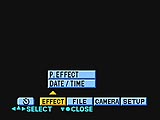 Effect:
Effect:
- Date/Time: Turns the date and time LCD display on and off.
- Picture Effect: Accesses the Solarize, Black & White, Sepia
and Negative Art picture effects.

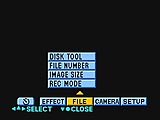 File:
File:
- Record Mode: Sets the still record mode to Text, Voice, E-Mail or
Normal. In Movie mode, allows you to change the minimum record time (in
response to a quick press of the shutter button) to five, 10 or 15 seconds.
- Image Size: Sets the still image sizes to 1600 x 1200, 1600
(3:2), 1600 (ECM), 1024 x 768 or 640 x 480. In Movie mode, sets the image
size to 320 x 240 or 160 x 112.
- File Number: Sets the file numbering to Series or Normal.
- Disk Tool: Allows you to format the disk, copy the disk or cancel
the selection.

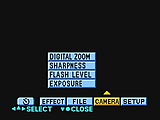 Camera:
Camera:
- Exposure: Sets the exposure compensation from -2.0 to +2.0 in 1/3
EV increments.
- Flash Level: Sets the flash intensity level to High, Normal or
Low.
- Sharpness: Sets the sharpness level anywhere from -2 to +2.
- Digital Zoom: Turns the 2x digital telephoto function on and
off.

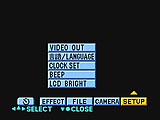 Setup:
Setup:
- LCD Bright: Adjusts the brightness of the LCD displays.
- Beep: Turns the camera's beep sound on or off.
- Clock Set: Changes the camera date and time settings.
- Language: Sets the menu language to English or Japanese.
- Video Out: Sets the camera's video out signal to NTSC or PAL
formats.
Playback Mode Menu: Activating the Playback menu pulls up the
following submenus:
- Index: Calls up a nine image index display.

- Delete: Deletes the currently displayed image with an option to cancel.

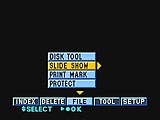 File:
File:
- Protect: Write protects the currently displayed image.
- Print Mark: Turns the camera's print mark on and off (date and
time stamp).
- Slide Show: Allows you to view captured images in a slide show
format, as well as set up time intervals and the number of repeats.
- Disk Tool: Allows you to format or copy the disk, with an option
to cancel.

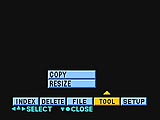 Tool:
Tool:
- Resize: Allows you to resize captured images.
- Copy: Copies the currently displayed image.

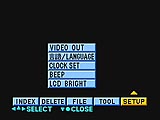 Setup:
Setup:
- LCD Bright: Adjusts the brightness of the LCD displays.
- Beep: Turns the camera's beep sound on or off.
- Clock Set: Changes the camera date and time settings.
- Language: Sets the menu language to English or Japanese.
- Video Out: Sets the camera's video out signal to NTSC or PAL
formats.
Image Storage and Interface
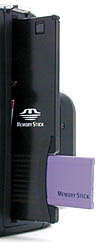 The MVC-FD95
records still images and movies to a 3.5 inch, 2HD, DOS formatted diskette.
This eliminates a good deal of the hassle of downloading files from the camera
to your computer, and is a primary reason for the huge popularity the Mavica
line has enjoyed in the marketplace. Instead of messing around with cables and
driver software, you just take the disk from the camera and put it in your computer.
A small disk icon on the camera's LCD display lets you know how much of the
disk is full and how many images have been shot. In addition to the standard
write protection of the entire diskette (simply slide the lock button on the
diskette itself), the MVC-FD95 allows you to protect individual images on the
disk from accidental erasure or alteration. All the standard rules for floppy
usage apply here, such as keeping diskettes away from heavy magnetic fields
and not getting them wet. This type of image storage is perfect for PC users,
who should have a floppy drive readily available on their machine. Newer Mac
users, however, will need to utilize an external floppy drive since the camera
doesn't have any digital connection jacks and the latest Macs don't come with
floppy drives.
The MVC-FD95
records still images and movies to a 3.5 inch, 2HD, DOS formatted diskette.
This eliminates a good deal of the hassle of downloading files from the camera
to your computer, and is a primary reason for the huge popularity the Mavica
line has enjoyed in the marketplace. Instead of messing around with cables and
driver software, you just take the disk from the camera and put it in your computer.
A small disk icon on the camera's LCD display lets you know how much of the
disk is full and how many images have been shot. In addition to the standard
write protection of the entire diskette (simply slide the lock button on the
diskette itself), the MVC-FD95 allows you to protect individual images on the
disk from accidental erasure or alteration. All the standard rules for floppy
usage apply here, such as keeping diskettes away from heavy magnetic fields
and not getting them wet. This type of image storage is perfect for PC users,
who should have a floppy drive readily available on their machine. Newer Mac
users, however, will need to utilize an external floppy drive since the camera
doesn't have any digital connection jacks and the latest Macs don't come with
floppy drives.
The downside of floppy storage though, is the limited capacity offered by the
medium: 1.44 megabytes was a lot of space a few years ago, when digicams with
0.3 megapixel sensors were considered high tech, but with the 2.1 megapixel
sensor of the FD95, things are definitely a bit cramped, and only 4 high-resolution
images can fit on a diskette at a time. This also means that the images stored
with a higher level of image compression than is common on other high end digital
cameras, resulting in higher levels of compression artifacts in the images.
Still, users of earlier Mavicas will find the image quality of the FD95 a dramatic
step up from the models they've used in the past.
As a solution to the space limitations of floppies, the MVC-FD95 can also store
images on Sony MemorySticks, via an accessory floppy disk adapter. This adapter
is the same size and shape of a standard floppy, but has a slot in the side
to accept a memory stick. The net result is a "floppy disk" with up to 64 megabytes
of capacity, enough for even an extended outing. We felt that this solution
worked quite well, but were disappointed to find that the FD95 can only read
or write to the Memory Stick/Adapter combination about half as fast as it can
to floppies. The adapter also requires driver software to be installed on your
PC to interface with it, eliminating some of the elegant simplicity of the floppy
disk solution.
You get a nice selection of image sizes with the MVC-FD95, from 1600 x 1200
to 1024 x 768 to 640 x 480. There's also a 1600 3:2 aspect image size which
crops the top and bottom of the image slightly and a higher-compression/lower
quality1600 ECM image option. ("ECM" apparently stands for "Economy")
Below is the approximate amount of images and compression ratios for a standard
1.44MB diskette:
| Resolution/Quality vs Image
Capacity |
High Resolution |
Standard Resolution |
Low Resolution |
|
Images |
Approx. Compression
|
Images |
Approx. Compression
|
Images |
Approx. Compression
|
| Normal Quality |
4 |
16:1 |
10 |
16:1 |
30 |
19:1 |
| ECM Mode |
8 |
32:1 |
N/A |
N/A |
N/A |
N/A |
Video Out
 An
audio/video output jack on the lens side of the camera allows you to connect the
camera to a television set. Through the capture menu, you can select NTSC or PAL
formats, depending on where you live. US and Japanese models come with the
necessary NTSC cables, while European models come with PAL connectors. All the
same image playback capabilities are available when connected to the TV, and you
have the added ability to record images to video tape. Unlike most digicams, the
FD95 can record still images, movies, and sound. Thus, the signal output jack
actually accommodates an "A/V" cable, with both video and audio connectors on
the other end.
An
audio/video output jack on the lens side of the camera allows you to connect the
camera to a television set. Through the capture menu, you can select NTSC or PAL
formats, depending on where you live. US and Japanese models come with the
necessary NTSC cables, while European models come with PAL connectors. All the
same image playback capabilities are available when connected to the TV, and you
have the added ability to record images to video tape. Unlike most digicams, the
FD95 can record still images, movies, and sound. Thus, the signal output jack
actually accommodates an "A/V" cable, with both video and audio connectors on
the other end.
Power
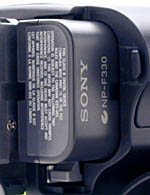 The MVC-FD95 comes
with a Sony InfoLITHIUM, NP-F330 rechargeable battery. (It can also use the
higher-capacity NP-F530 and NP-F550 batteries.) InfoLITHIUM technology means
that the battery communicates with the camera to let you know how much power is
left (displayed on the LCD panel in minutes remaining as well as via a battery
icon). If you need to run the camera for longer periods than the battery pack
will allow, the supplied AC adapter should do the trick. There's also an auto
power-off function which shuts down the camera after three minutes of
inactivity. The AC adapter also acts as the battery charger. You simply leave
the battery in the camera and plug in the AC adapter. If the camera is switched
off, the "Charge" LED will light up (located directly over the power
switch).
The MVC-FD95 comes
with a Sony InfoLITHIUM, NP-F330 rechargeable battery. (It can also use the
higher-capacity NP-F530 and NP-F550 batteries.) InfoLITHIUM technology means
that the battery communicates with the camera to let you know how much power is
left (displayed on the LCD panel in minutes remaining as well as via a battery
icon). If you need to run the camera for longer periods than the battery pack
will allow, the supplied AC adapter should do the trick. There's also an auto
power-off function which shuts down the camera after three minutes of
inactivity. The AC adapter also acts as the battery charger. You simply leave
the battery in the camera and plug in the AC adapter. If the camera is switched
off, the "Charge" LED will light up (located directly over the power
switch).
We love the InfoLITHIUM battery technology, because you know
within a few seconds of turning the camera on exactly how much charge/operating
time is left. Overall battery capacity is quite good, and buying a NP-F550
battery gives very good operating life. Finally, the lithium-ion technology used
in the InfoLITHIUM cells means that the batteries don't "self-discharge,"
holding their full charge when not in use, for months at a time. Sony estimates
that a fully charged NP-F330 will provide approximately 65 minutes of continuous
recording time and about 80 minutes of continuous playback. These number agree
well with our own measurements, and in fact seemed a bit conservative, as we
measured 97 and 127 minutes respectively, with a freshly charged, new battery
pack. (As with other Sony cameras, the InfoLITHIUM system prevented us from
making our normal power-consumption measurements, so the record/playback times
above are the extent of what we can tell you about the FD-95's power
consumption.)
Included
Software
Included with the MVC-FD95 is a software CD loaded with
ArcSoft's Camera Studio package, compatible with Windows 95, 98 and NT as well
as Mac OS 7.5 and higher. The software comes in English, French, German,
Italian, Spanish and Japanese versions. The Camera Studio bundle includes ArcSoft's PhotoStudio and VideoImpression
programs. PhotoStudio provides image correction capabilities and a number of
creative options for enhancing your images. Several image effect tools give you
total creative control. VideoImpression works along similar lines, giving you
basic editing tools that allow you to add music and text to movie
files.
Test Results
In keeping with our standard
policy, our comments here are rather condensed, summarizing our key findings.
For a full commentary on each of the test images, see the MVC-FD95's "pictures" page.
As with all Imaging
Resource camera tests, we encourage you to let your own eyes be the judge of how
well the devices performed. Explore the images on the pictures page, to see how well the FD95 performed, and
how its images compare to other cameras you may be considering
buying.
Overall, the FD95 produced very good images, with excellent color
and good detail. Color accuracy was very nice throughout our testing, although
the large cyan and yellow blocks on our Davebox target appeared slightly weak in
their saturation level. The camera's white balance system seemed to handle most
lighting situations well, with the manual (One-Push) adjustment option providing
the most accurate results the majority of the time. Still, we were very
impressed with the color results.
In the resolution department, the FD95
performed about in the middle of the pack among 2 megapixel cameras we've
tested. We "called" the visual resolution at about 800 lines horizontally, 650
vertically. We saw more color moire patterns and artifacts in the vertical axis,
but they weren't too severe in either direction. Sharpness is just a bit off the
top of the current 2 megapixel pack of cameras though, due largely to the higher
levels of JPEG compression the FD95 has to use to fit even four high-resolution
images onto a floppy disk. Overall, a good performance though, likely a very
welcome upgrade to fans of the earlier 800K pixel FD91. (If you liked the Mavica
line before, you should really love the FD95, as it provides a pretty dramatic
increase in resolution and picture-taking flexibility.)
Optical
distortion on the MVC-FD95 is a little high at the wide angle end, showing
approximately 0.9 percent barrel distortion. However, we found virtually no
pincushion distortion at the telephoto end (at least none that we could
effectively measure). Chromatic aberration was moderate, showing about two
pixels of coloration on each side of the black resolution target corner
elements. (This distortion is visible as a very slight colored fringe around the
objects at the edges of the field of view on the resolution target). There is
also some lens flare in the corners of the image in telephoto mode. Taken as a
whole though, lens performance is very good, particularly in light of the
exceptional 10x zoom range. (Long-ratio zooms are very tough to design so as to
avoid distortion. Sony's optical engineers seem to have done a fine
job.)
The FD95 offers good exposure control, with a variety of Program AE
modes that include Shutter Priority, Aperture Priority, Twilight, Twilight Plus,
Landscape, Panfocus and Automatic exposure modes (although there's no full
manual mode, which is something we like to see on a higher end camera like this
one). There's also a choice between spot and matrix metering. We found excellent
highlight detail in many of our tests, particularly noticeable in the white
cheesecloth section of the Davebox target and the strong highlights of the
model's shirt in our outdoor portrait test.
One of the most obvious
limitations of the original Mavicas was their low-light performance: You just
couldn't take pictures in very dark surroundings. We were therefore surprised to
see the excellent results we obtained with the FD95 even in very dark
conditions: The FD95 is comfortably in the current (June, 2000) first rank in
the low-light arena! In straight Automatic Exposure mode, the MVC-FD95's low
light capabilities weren't too impressive (only going down as far as 1
foot-candle, or 11 lux), but in Shutter Priority exposure mode exposure times as
long as 8 seconds produced a surprisingly good (although noisy) image at 1/16 of
a foot-candle (0.7 lux). (!) We'd rate the FD95 as producing very good images
down to light levels of 0.5 foot-candles (5.5 lux), and usable ones to levels of
1/4 of a foot-candle (2.6 lux) and below. (For reference, a city night scene
under typical street lighting corresponds to an illumination level of 1
foot-candle.)
We found the MVC-FD95's LCD monitor to be just a little tight, showing about
92 percent of the final image area at both wide angle and telephoto settings. We
assume that the optical viewfinder has the same accuracy level, since it's
basically a smaller version of the rear LCD panel. Although we generally like to
see LCD monitors as close to 100 percent accuracy as possible, the MVC-FD95 is
more accurate than most. We generally like to see LCD monitors as close to 100
percent accuracy as possible, so the FD95 falls just a little short in that
category. (Although 92% is more accurate than most cameras we've tested.)
The MVC-FD95 performs superbly in the macro category, capturing a minimum
area of 2.12 x 1.59 inches (53.95 x 40.46 mm) at the furthest wide angle
setting. The lens does seem to have a bit of a "sweet spot" in macro mode,
allowing you to partially zoom in and capture an even smaller minimum area of
only 1.42 x 1.06 inches (35.96 x 26.97mm). Macro lighting with it is a little
tricky though, because the large lens and close working distance blocks some of
the light and forces a very shallow lighting angle. Ultra-macro optics
usually show some optical imperfections this close, and the FD-95's lens is no
exception. Still, the level of distortion seems to be less than we've come to
expect, with some barrel distortion, curvature of field and lens flare in the
corners all present, but not as severe as we've seen in some other ultra-macro
lenses.
Overall, the MVC-FD95 performed very well in our testing, with very good
color accuracy, low light and macro results. It's clearly a substantial step
forward for the Mavica line in terms of image quality and shooting
flexibility.
Conclusion
Despite its
somewhat bulky dimensions, we really liked what the MVC-FD95 had to offer, and
found it an enjoyable camera to work with. Besides the floppy-disk image storage
(somewhat of a mixed blessing, in our judgment, due to the image compression
levels it demands), the MVC-FD95's standout feature is clearly its 10x optical
zoom lens. Our earlier review of the 14x-equipped 0.8 megapixel FD91 Mavica was
subtitled "resolution isn't everything," pointing out how many more pixels that
camera could deliver on-subject than even 2 megapixel competitors with typical
3x optical zooms. With its 10x zoom, the 2.1 megapixel FD95 clearly takes the
cake for the ultimate telephoto workhorse, at least at the current time in the
digicam marketplace (June, 2000). The lens' optical stabilization system is also
remarkably effective for hand-holding those super-telephoto shots, producing
crisp images at shutter speeds way slower than you'd expect to be usable.
With upgraded 12-bit digitization, great tonal range and color reproduction, and
excellent low-light performance, the FD95 is a flexible photographic tool that's
also easy for novices to master in full-auto mode. We expect large numbers of
prior Mavica owners will find the FD95 an excellent upgrade to bring them into
the 2.1 megapixel arena, and many more will be sold to new owners as
well.
<<MVC-FD95 Sample Images
| Additional Resources and Other Links>>
Reader Comments!
Questions, comments or controversy on this product? Click
this link to see what other Imaging Resource readers have had to say about
the Sony MVC-FD95, or add comments of your own!
Back
to Full Sony MVC-FD95 Review
The MVC-FD95 offers both a rear LCD panel and optical
viewfinder (which seems to be a smaller version of the LCD). The "optical" viewfinder
actually uses a tiny (and lower-power) LCD screen to show you what the camera's
seeing. Sort of an "electronic SLR" (single-lens reflex), similar to the design
of the MVC-FD91 model. What makes the optical viewfinder interesting is the
internal information display, which is identical to that of the LCD monitor
(complete with navigable menus). The idea of being able to see the exposure
settings in the viewfinder is a good one, but navigating the menus through the
optical viewfinder is a bit of a trick (one we weren't able to easily do). We
found it much easier to simply switch on the LCD monitor when we needed to change
menu options. The optical viewfinder does feature a dioptric adjustment dial
for eyeglass wearers, which is always a nice bonus. The 2.5 inch LCD monitor
is turned on and off by the LCD On/Off button directly to its left, and the
information display is controlled by the Display button just beneath the monitor.
The MVC-FD95 is equipped with a 10x, 6 to 60 mm lens (equivalent to
a 39 to 390mm lens on a 35mm camera). The FD95 also boasts the surprisingly
effective "Steady Shot" anti-vibration system, which increases your chances
of being able to hand-hold exposures with such a long telephoto. (The rule of
thumb in the film-camera world has always been that you should use a shutter
speed of one divided by the focal length of your lens in millimeters, to avoid
blur from camera shake. Thus, for a 400 mm lens, you should use a shutter speed
of at least 1/400 of a second.) As we discovered with the FD91, the Steady Shot
system does an excellent job of steadying the image in the viewfinder when working
at the maximum telephoto setting. While we don't have any objective way to measure
how effective the Steady Shot system is, our distinct impression was that the
FD95's Steady Shot system is significantly improved over that of the earlier
FD91: It really does provide an amazing reduction in the amount of camera shake
that makes it through to the CCD!
The MVC-FD95
records still images and movies to a 3.5 inch, 2HD, DOS formatted diskette.
This eliminates a good deal of the hassle of downloading files from the camera
to your computer, and is a primary reason for the huge popularity the Mavica
line has enjoyed in the marketplace. Instead of messing around with cables and
driver software, you just take the disk from the camera and put it in your computer.
A small disk icon on the camera's LCD display lets you know how much of the
disk is full and how many images have been shot. In addition to the standard
write protection of the entire diskette (simply slide the lock button on the
diskette itself), the MVC-FD95 allows you to protect individual images on the
disk from accidental erasure or alteration. All the standard rules for floppy
usage apply here, such as keeping diskettes away from heavy magnetic fields
and not getting them wet. This type of image storage is perfect for PC users,
who should have a floppy drive readily available on their machine. Newer Mac
users, however, will need to utilize an external floppy drive since the camera
doesn't have any digital connection jacks and the latest Macs don't come with
floppy drives.